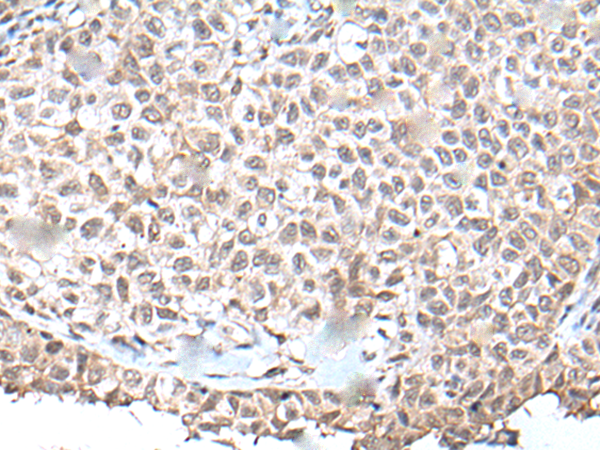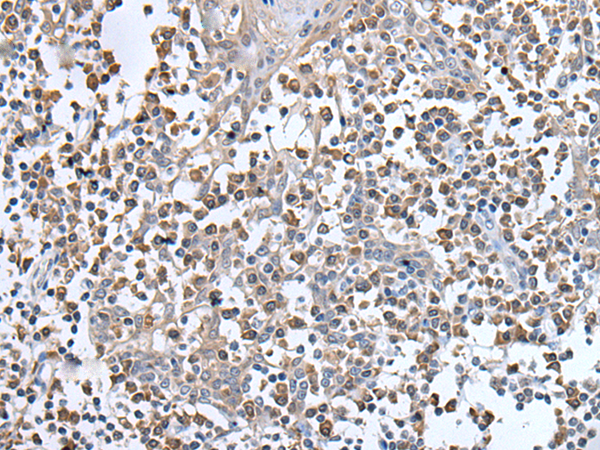

| WB | 咨询技术 | Human,Mouse,Rat |
| IF | 咨询技术 | Human,Mouse,Rat |
| IHC | 1/50-1/300 | Human,Mouse,Rat |
| ICC | 技术咨询 | Human,Mouse,Rat |
| FCM | 咨询技术 | Human,Mouse,Rat |
| Elisa | 1/5000-1/10000 | Human,Mouse,Rat |
| Aliases | VT; VT4 |
| Host/Isotype | Rabbit IgG |
| Antibody Type | Primary antibody |
| Storage | Store at 4°C short term. Aliquot and store at -20°C long term. Avoid freeze/thaw cycles. |
| Species Reactivity | Human, Mouse |
| Immunogen | Synthetic peptide of human UBN1 |
| Formulation | Purified antibody in PBS with 0.05% sodium azide and 50% glycerol. |
+ +
以下是关于UBN1抗体的3篇参考文献,涵盖其功能、应用及相关研究:
---
1. **文献名称**:*UBN1 interacts with the HIRA complex to regulate epigenetic silencing of senescence-promoting genes*
**作者**:Zhang, R., et al.
**摘要**:该研究揭示UBN1作为HIRA复合物的关键组分,通过ChIP和免疫共沉淀实验(使用UBN1抗体)证明其参与组蛋白H3.3的沉积,调控衰老相关基因的表观遗传沉默,为细胞衰老机制提供新见解。
---
2. **文献名称**:*Spatial reorganization of the genome during cellular senescence*
**作者**:Bártová, E., et al.
**摘要**:通过免疫荧光和超分辨率显微技术(结合UBN1抗体),本文发现UBN1在衰老细胞中促进异染色质结构的空间重组,支持其在维持基因组稳定性中的作用。
---
3. **文献名称**:*Structural basis for recognition of H3K36me3 by the UBN1 subunit of the HIRA complex*
**作者**:Shah, P.P., et al.
**摘要**:研究解析了UBN1的晶体结构,利用Western blot和免疫沉淀(依赖UBN1抗体)验证其通过Bromo域识别H3K36me3标记,阐明其在染色质重塑中的分子机制。
---
这些文献均涉及UBN1抗体的实验应用(如免疫沉淀、Western blot、免疫荧光),聚焦于UBN1在染色质调控和衰老中的功能。如需更多文献或具体细节,建议通过PubMed或Google Scholar进一步检索。
**Background of UBN1 Antibody**
UBN1 (Ubinuclein-1) is a critical component of the HIRA histone chaperone complex, which mediates the deposition of the histone variant H3.3 into chromatin. This process is essential for chromatin remodeling, transcriptional regulation, and genome stability. UBN1 facilitates the recognition of specific histone modifications, such as H3K36me3. guiding the HIRA complex to target loci, including gene promoters and regulatory elements. UBN1 antibodies are vital tools for studying its expression, localization, and functional roles in cellular processes like DNA replication, repair, and cellular differentiation. Dysregulation of UBN1 has been implicated in developmental disorders, aging, and cancers, as its loss may disrupt chromatin integrity and gene expression. Researchers employ UBN1 antibodies in techniques like immunoblotting, immunofluorescence, and ChIP-seq to explore its contributions to epigenetic regulation and disease mechanisms, enhancing understanding of its role in maintaining genomic and epigenetic homeostasis.
×